Overview of GPS Tracking Systems
GPS tracking systems are revolutionising how individuals monitor their vehicles. At their core, these systems utilise satellites to determine a vehicle’s precise location at any given time. This satellite-based navigation system works by sending signals to a receiver in the vehicle, which then relays the data to a central server for tracking.
The advantages of installing a GPS tracking system in your vehicle are numerous. Firstly, they provide enhanced security by allowing you to keep tabs on your vehicle’s movements, proving invaluable in case of theft. Moreover, they offer logistical benefits for businesses, enabling fleet managers to track delivery routes and optimise journeys for efficiency.
Additional reading : Mastering diesel fuel injection: key strategies for inspection and maintenance
Basic components within a GPS tracking system include a GPS receiver, an antenna, and a communication unit. The GPS receiver gathers satellite signals, while the antenna ensures these signals are obtained accurately, even in challenging environments. The communication unit, often connected via cellular networks, facilitates the transmission of location data to a central system where it can be accessed by users, providing real-time location information.
Safety Precautions Before Installation
Before beginning the installation of a GPS tracking system, it is imperative to prioritise safety precautions to prevent any mishaps. Begin by thoroughly reading the manufacturer’s manual. This document contains crucial information about specific installation procedures and safety guidelines specific to your GPS tracking system model. Understanding these instructions will help you to avoid mistakes and ensure a smooth installation process.
In parallel : Crucial safety guidelines for inspecting electrical systems in hybrid cars
Ensure the vehicle is turned off and parked securely on level ground. This reduces the risk of accidental movement during the installation process. Additionally, release the parking brake to ensure utmost stability.
Gather all necessary safety gear and tools before you start working on the vehicle. Recommended equipment might include insulated gloves, safety goggles, and a well-equipped toolkit containing screwdrivers, wire cutters, and electrical tape. Having the correct tools at hand negates the need for makeshift solutions, enhancing both safety and efficiency.
By observing these pre-installation tips, you enhance both personal and vehicle safety during the installation process. This preparation lays the groundwork for a successful installation, paving the way for a functioning and reliable GPS tracking system.
Step-by-Step Installation Guide
Taking the leap to incorporate modern GPS tracking systems into your vehicle can be highly beneficial. However, the key lies in a detailed understanding of the GPS installation process.
Preparation Steps
Before you start, ensure you have all required tools and equipment. Typical items include screwdrivers, wire cutters, and electrical tape. You should also choose a secure location within the vehicle for the GPS unit. Placing it somewhere that doesn’t obstruct your field of vision and remains shielded from harsh weather conditions is ideal.
Wiring the GPS Unit
The next step in the installation steps involves connecting the GPS unit to your vehicle’s power source. This usually requires attaching wires from the GPS device to the vehicle’s battery or fuse box. Ensure each wire is connected securely to avoid any malfunctions.
Securing the GPS Device
Once wired, securely fasten the GPS device within the vehicle. Consider options like Velcro strips or brackets to ensure it remains in position. Best practices dictate positioning the GPS in a location that ensures optimal signal reception.
Understanding these steps simplifies the vehicle GPS setup, paving the way for successful tracking capabilities to be leveraged.
Potential Hazards and How to Avoid Them
Navigating the intricacies of a GPS installation can pose certain hazards if precautionary measures aren’t adhered to. Addressing these potential issues ensures both the safety and effectiveness of your vehicle tracking system.
Common Mistakes
Many installers inadvertently make errors during the GPS installation process. One critical mistake is neglecting to securely fasten the GPS device. This can lead to dislodgement during travel, compromising signal reception. Ensure that all brackets and fasteners are checked for tightness.
Risks and Electronics
Improper handling of vehicle electronics is among the top risks during installation. Incorrectly wiring the GPS unit might not only render the system inoperative but also interfere with other critical vehicle functionalities. Use insulated tools and maintain a focus on detailed installation guidelines to prevent short circuits or electrical issues.
Legal Considerations
Understanding the legalities involved in GPS usage is crucial. Ensure the installation abides by privacy laws, respecting consent protocols, especially in contexts involving monitored individuals (e.g., employees in fleet vehicles).
Avoiding these pitfalls during your GPS installation will provide a seamless setup and maintain both personal and vehicular safety.
Troubleshooting Tips After Installation
Installing a GPS tracking system is just the first step in effective vehicle tracking. Addressing potential challenges post-installation is equally crucial to ensure the system remains operational.
Checking GPS Signal and Connectivity
After installation, confirm that the GPS system maintains a robust signal. A weak signal often results from poor antenna positioning or obstructions. Relocate the antenna if necessary to enhance connectivity. Checking the power connection to ensure it is secure can also rectify signal issues.
Common Issues and Solutions
Troubleshoot common GPS issues such as delayed location updates or inconsistent tracking by inspecting wiring connections. Loose connections or improper wiring can disrupt functionality. If there’s inconsistent data transmission, verify that the communication unit is properly connected to the vehicle’s power source and cellular network.
Regular Maintenance Tips
Regular maintenance enhances GPS performance, preventing recurring issues. Periodically check wiring integrity and clean dust or debris from the apparatus to avoid signal interference. Additionally, updating the system’s software keeps it compatible with technological advancements and fixes bugs that might affect overall performance.
These post-installation checks and maintenance strategies ensure that your GPS system operates at peak efficiency, maintaining seamless tracking capabilities.









